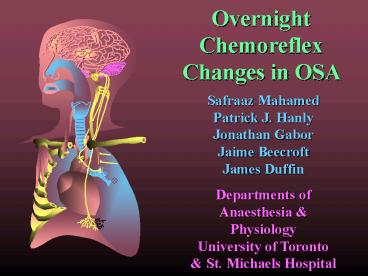Overnight Chemoreflex Changes in OSA - PowerPoint PPT Presentation
1 / 18
Title:
Overnight Chemoreflex Changes in OSA
Description:
Departments of Anaesthesia & Physiology University of Toronto & St. Michaels Hospital. We hypothesized that the numerous episodes of hypoxia, hypercapnia and arousal ... – PowerPoint PPT presentation
Number of Views:84
Avg rating:3.0/5.0
Title: Overnight Chemoreflex Changes in OSA
1
Overnight Chemoreflex Changes in OSA
Safraaz Mahamed Patrick J. Hanly Jonathan Gabor
Jaime Beecroft James Duffin Departments
of Anaesthesia Physiology University of
Toronto St. Michaels Hospital
2
We hypothesized that the numerous episodes of
hypoxia, hypercapnia and arousal experienced by
OSA patients induce overnight changes in
respiratory chemoreflexes.
Two modified rebreathing tests hyperoxic for
central hypoxic for central
peripheral
morning
evening
Overnight sleep assessment for OSA
3
500 patients were screened after being referred
to the St. Michaels Hospital Sleep Laboratory
for OSA assessment.
35 volunteered to participate in this study. All
were non-smokers, medication free, with no
history of cardio-respiratory disease, and with a
BMI less than 40.
These 35 patients were separated into non-OSA and
OSA groups based on their apnoea-hypopnoea
indices (AHI) non-OSA patients had AHIs lt 10
OSA patients had AHIs gt 30 those between these
limits were excluded.
4
Group Characteristics
5
Sleep Measures
6
non-OSA subject A
non-OSA subject B
Isoxic Po2 50 mmHg
Isoxic Po2 150 mmHg
Ventilation BTPS (L/min)
morning
evening
OSA subject D
OSA subject C
Isoxic Po2 150 mmHg
Isoxic Po2 50 mmHg
Ventilation BTPS (L/min)
VEs1
VEt1
Predicted Pco2 (mmHg)
Predicted Pco2 (mmHg)
7
Hypoxia (non-OSA)
Hyperoxia (non-OSA)
Sensitivity (L/min/mmHg)
Sensitivity (L/min/mmHg)
evening
morning
evening
morning
Hypoxia (OSA)
Hyperoxia (OSA)
21.0
12.3
Sensitivity (L/min/mmHg)
Sensitivity (L/min/mmHg)
morning
evening
morning
evening
8
Hypoxia (non-OSA)
Threshold (mmHg)
Threshold (mmHg)
Hyperoxia (non-OSA)
evening
morning
evening
morning
Hypoxia (OSA)
Threshold (mmHg)
Threshold (mmHg)
Hyperoxia (OSA)
evening
morning
evening
morning
9
Overnight Changes
Basal (non-chemoreflex) ventilation no change in
either group
Rate of rise of Pco2 (metabolism) decreased in
both groups
Chemoreflex Threshold decreased in non-OSA group
Chemoreflex Sensitivity increased in OSA group
10
Respiratory System Stability Loop Gain
Oscillations
Plant Gain
Ventilation
time
Feedback Gain
Loop Gain
Too large and instability results
11
Loop Gain Changes Threshold Decreases
Loop Gain Decreases
Plant Gain - Decreases
Feedback Gain - No Change
For the same Pco2 increase, ventilation increases
the same
For the same ventilation increase, Pco2 decreases
less
Ventilation
Ventilation
Pco2
Pco2
12
Loop Gain Changes Metabolism Decreases
Loop Gain Increases
Plant Gain - Increases
Feedback Gain - No Change
Ventilation
Ventilation
For the same ventilation increase, Pco2 decreases
more
For the same Pco2 increase, ventilation decreases
the same
Pco2
Pco2
13
Loop Gain Changes Sensitivity Increases
Loop Gain Increases
Feedback Gain - Increases
Plant Gain - Decreases
Ventilation
Ventilation
For the same ventilation increase, Pco2 decreases
less
For the same Pco2 increase, ventilation increases
more
Pco2
Pco2
14
Consequences for Stability Loop Gain
Non-OSA
OSA
Decreased threshold counteracts effect of
metabolism decrease
Increased sensitivity adds to the effect of
metabolism decrease
Plant feedback gain increased in the morning
Plant gain increased in the morning
Ventilation
Ventilation
morning
morning
evening
evening
Pco2
Pco2
15
Respiratory System Stability CO2 Reserve
An increase in loop gain causes swings in Pco2
above and below the chemoreflex threshold
promoting episodes of apnoea
Apnoeas
Ventilation
time
Ventilation
Pco2
16
Consequences for Stability CO2 Reserve
OSA
Non-OSA
Increased sensitivity adds to the effect of
metabolism decrease
Decreased threshold counteracts the effect of
metabolism decrease
morning
morning
evening
evening
Ventilation
Ventilation
CO2 reserve decreases
CO2 reserve decreases
Pco2
Pco2
17
Conclusions Overnight Changes in Stability
In both groups the decreased metabolism decreases
stability, and decreases CO2 reserve.
In the OSA group, the increased chemoreflex
sensitivity decreases stability and decreases CO2
reserve.
In the non-OSA group, the decreased chemoreflex
threshold increases stability and increases CO2
reserve.
18
Acknowledgements
Funded by Canadian Institutes of Health Research
The Ontario Thoracic Society.
For additional information on the Respiratory
Research Group visit http//www.utoronto.ca/respg
rp/

